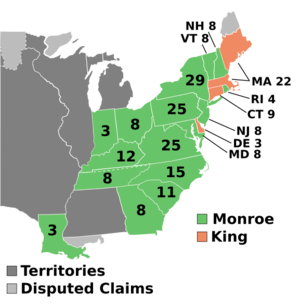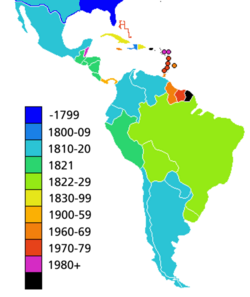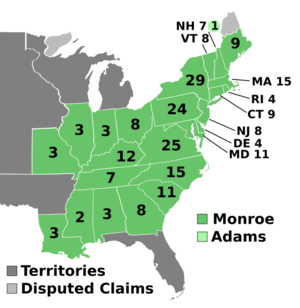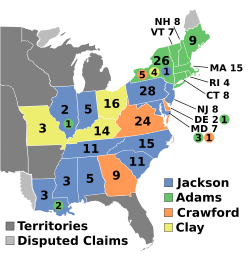Presidency of James Monroe facts for kids
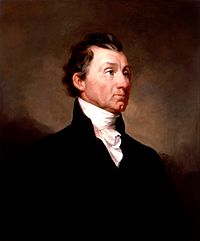 |
|
Quick facts for kids
Presidency of James Monroe
|
|
|---|---|
| March 4, 1817 – March 4, 1825 | |
| Cabinet | See list |
| Party | Democratic-Republican |
| Election |
|
| Seat | White House |
|
← James Madison • John Quincy Adams →
|
|
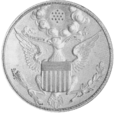 |
|
| Dorsett seal | |
The presidency of James Monroe began on March 4, 1817. James Monroe became the fifth U.S. President after winning the 1816 election. He won by a huge amount against Federalist Rufus King. This was the last time the Federalist Party had a candidate for president. Monroe ran for president again in 1820 and had no opponents.
Monroe was a member of the Democratic-Republican Party. He wanted to get rid of political parties altogether. The Federalist Party disappeared during his time as president. Even the Democratic-Republicans stopped acting as one big party. This time is often called the "Era of Good Feelings" because there was very little fighting between political groups.
At home, Monroe faced the Panic of 1819. This was the first major economic downturn in American history. He supported many government-funded projects to improve roads and canals. However, he stopped some projects because he worried if the government had the right to fund them. Monroe signed the Missouri Compromise. This law allowed Missouri to join the U.S. as a state where slavery was allowed. But it also stopped slavery in new territories north of a certain line (36°30′ north).
In foreign policy, Monroe and his Secretary of State, John Quincy Adams, bought East Florida from Spain. This was a goal Monroe and earlier presidents had wanted for a long time. The Adams–Onís Treaty was signed after the First Seminole War. It also made sure the U.S. controlled West Florida. The treaty set the western border of the United States. Spain also gave up its claims to the Oregon Country.
Monroe's government also signed two treaties with Britain. This helped improve relations between the two countries after the War of 1812. The Rush–Bagot Treaty removed military ships from the U.S. border with British North America. The Treaty of 1818 settled some border disagreements. It also allowed both countries to settle the Oregon Country together for a time.
Monroe felt strongly for the countries in Latin America that were fighting for independence. He did not want European countries to have influence there. In 1823, Monroe announced the Monroe Doctrine. This policy said the U.S. would stay neutral in European problems. But it also said the U.S. would not allow new European colonies in Latin America.
In the 1824 election, four Democratic-Republican leaders wanted to become president. Monroe stayed neutral and did not pick a favorite. John Quincy Adams won the election. He defeated General Andrew Jackson and Secretary of the Treasury William H. Crawford. Historians and political experts usually rank Monroe as an above-average president.
Contents
Becoming President in 1816
James Monroe was a strong leader during the War of 1812. This made him the likely choice to be the next president for the Democratic-Republican Party. However, not all party leaders supported him at first. Some leaders from the South and West preferred William H. Crawford. They were worried about Monroe's support for the Second Bank of the United States. New York leaders wanted their governor, Daniel D. Tompkins, to be president. They did not want another president from Virginia.
Crawford did not strongly oppose Monroe. He hoped to become president after Monroe. In March 1816, the Democratic-Republicans held a meeting to choose their candidate. Monroe won the vote 65 to 54. He became the party's choice for president. Tompkins was chosen as the vice presidential candidate.
The Federalist Party was very weak after the War of 1812. They had opposed the war, which made them unpopular. They chose Rufus King as their candidate. But the Federalists offered little challenge to Monroe. Some people tried to get DeWitt Clinton to run against Monroe. Clinton had run against James Madison in 1812. But Clinton decided not to enter the race.
Monroe won 183 out of 217 electoral votes. He won every state except Massachusetts, Connecticut, and Delaware. The Democratic-Republicans also gained more seats in Congress. They ended up controlling more than three-quarters of the House of Representatives. Monroe was the last president to be called a Founding Father of the United States. He was also the last president from the "Virginia dynasty." This term describes how four of the first five presidents were from Virginia.
Monroe's Administration
| The Monroe Cabinet | ||
|---|---|---|
| Office | Name | Term |
| President | James Monroe | 1817–1825 |
| Vice President | Daniel D. Tompkins | 1817–1825 |
| Secretary of State | Richard Rush (acting) | 1817 |
| John Quincy Adams | 1817–1825 | |
| Secretary of Treasury | William H. Crawford | 1817–1825 |
| Secretary of War | George Graham (acting) | 1817 |
| John C. Calhoun | 1817–1825 | |
| Attorney General | Richard Rush | 1817 |
| William Wirt | 1817–1825 | |
| Secretary of the Navy | Benjamin Williams Crowninshield | 1817–1818 |
| Smith Thompson | 1819–1823 | |
| Samuel L. Southard | 1823–1825 | |
Monroe chose a cabinet with members from different parts of the country. This helped him lead the government. He asked Crawford to stay on as Treasury Secretary. He also kept Benjamin Williams Crowninshield as Secretary of the Navy. Richard Rush continued as Attorney General.
To make people in the North happy, Monroe chose John Quincy Adams from Massachusetts as Secretary of State. This was a very important job. Adams became the early favorite to be the next president. Adams was an experienced diplomat. He had left the Federalist Party in 1807 to support Thomas Jefferson's foreign policy. Monroe hoped Adams's appointment would encourage more Federalists to join the Democratic-Republicans.
Monroe offered the job of Secretary of War to Henry Clay from Kentucky. But Clay only wanted to be Secretary of State. Monroe's choice of Adams for that role made Clay unhappy. Clay often disagreed with Monroe's policies. After Andrew Jackson and Isaac Shelby turned down the Secretary of War job, Monroe chose John C. Calhoun. Calhoun was a Congressman from South Carolina. This meant the cabinet did not have a strong leader from the West. Later, Rush became the ambassador to Britain. William Wirt took over as Attorney General. Most of Monroe's cabinet members stayed in their jobs for his entire presidency.
Domestic Issues
One Dominant Political Party

Like the presidents before him, Monroe believed that political parties were bad for the United States. He wanted to get rid of them during his presidency. He tried to make the Democratic-Republican Party stronger. He did this by avoiding policies that would cause arguments. He also welcomed former Federalists into the party. His main goal was for the Federalist Party to disappear completely.
Monroe took two long trips across the country. He wanted to build trust among Americans. When he visited Boston in 1817, people called it the start of an "Era of Good Feelings." He stopped often on these trips. This allowed many welcoming ceremonies and good feelings to be shared. More Americans saw Monroe than any president before him. His travels were reported in newspapers everywhere.
The Federalist Party could not create a strong national plan. Their candidates often focused on local issues, not national ones. The Federalists still had some power in Delaware and a few other places. But they had little power in national politics. Because there was no strong opposition, the Democratic-Republican Party stopped holding regular meetings. For all practical purposes, the Democratic-Republican Party stopped working as a unified party.
Economic Troubles of 1819
Two years into Monroe's presidency, the country faced an economic crisis. It was called the Panic of 1819. This was the first major economic depression in U.S. history. The panic happened because imports and exports went down. Also, farm prices dropped as the world adjusted to peacetime after the War of 1812 and the Napoleonic Wars.
The economic problems in the U.S. were made worse by too much speculation in public lands. This was fueled by banks printing too much paper money. The Second Bank of the United States (B.U.S.) did not control inflation until late 1818. Then, the bank's leaders finally took steps to reduce credit. They told branches to only accept their own bills. They also demanded immediate payment for all state bank notes. They stopped renewing personal notes or mortgages. These strict money policies backfired. They made people lose trust in banks. This helped cause the panic.
Monroe had little power over economic policy. In the early 1800s, states and the B.U.S. had most of this power. As the panic spread, Monroe did not call a special meeting of Congress. When Congress met again in December 1819, Monroe asked for higher tariffs (taxes on imported goods). But he did not suggest specific rates. Congress did not raise tariffs until 1824. The panic led to high unemployment. Many businesses went bankrupt. People lost their homes. It also made people angry at banks and businesses.
People's anger towards the national bank led Maryland to tax the bank's branch there. Soon after, the Supreme Court made a decision in McCulloch v. Maryland. This was a big loss for those who supported states' rights. The Supreme Court said states could not tax B.U.S. branches. Chief Justice John Marshall wrote that the Constitution gave Congress "powers that were not expressly defined." This decision made people dislike the B.U.S. even more. It also raised fears about the federal government's growing power.
The Missouri Compromise
In 1818, Henry Clay and John Scott wanted Missouri Territory to become a state. The House of Representatives did not act on the bill before Congress ended its session. But they discussed it again in December 1818. During these talks, Congressman James Tallmadge Jr. from New York caused a big stir. He suggested changes to the bill. These changes would stop new enslaved people from being brought into Missouri. They would also free children born to enslaved parents when they turned twenty-five.
These changes started the biggest national debate about slavery since the Constitution was written. It immediately showed how divided the country was over slavery. Northern Democratic-Republicans and some Federalists joined together. They supported stopping slavery in Missouri and all future states. Southern Democratic-Republicans were almost all against such limits. Northerners said slavery was wrong. Southerners argued that banning slavery in a state was against the Constitution.
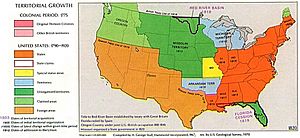
Some Southerners, like former President Jefferson, said that spreading enslaved people to the west would make it easier to free them slowly. But most white Southerners supported spreading slavery. They believed it would help prevent unrest. Both sides also knew that Missouri's status would affect the balance of slave states and free states in the Senate.
The bill, with Tallmadge's changes, passed the House. Most votes were divided by region. The Senate rejected both changes. A special committee from both houses could not agree. So, the whole bill failed. Congress discussed the issue again in December 1819. Monroe, who owned enslaved people, threatened to veto any bill that limited slavery in Missouri. He also supported Senator James Barbour and other Southern Congressmen. They tried to get Missouri admitted as a slave state. They threatened to delay statehood for Maine, which was part of Massachusetts at the time.
In February 1820, Congressman Jesse B. Thomas from Illinois suggested a compromise. Missouri would be a slave state. But slavery would be banned in all other territories north of the parallel 36°30′ north. Monroe and other Southern leaders saw this as the best outcome for slaveholders. With help from national bank president Nicholas Biddle, Monroe used his influence to gain support for Thomas's plan. The Senate passed a bill that included Thomas's slavery restriction. It also allowed Maine and Missouri to become states. The House approved the Senate bill by a close vote. After talking with his cabinet, Monroe signed the law in April 1820.
The final admission of Missouri came up again in November 1820. Missouri's constitution said that free black people could not enter the state. Many Northerners thought this was against the Constitution. The argument over Missouri affected the 1820 presidential election. Congress reported election results both with and without Missouri's votes. With Henry Clay's help, a law was finally passed. It said that Missouri's rule could "never be used to pass any law" that harmed the rights of any U.S. citizen. This unclear rule is sometimes called the Second Missouri Compromise. It was a difficult decision for many. The admission of new states as free or slave became a major issue until slavery was ended.
The Missouri Compromise had several important effects. It helped prevent the Democratic-Republican Party from splitting. This happened when the Federalists offered little opposition. It also set a rule that free states and slave states would be admitted in pairs. This helped keep the balance in the Senate. The compromise also raised the importance of both Henry Clay and the Senate. Most importantly, the Missouri Compromise showed a change. The idea of slowly freeing enslaved people, once popular in the South, was fading. The planned uprising by Denmark Vesey in 1822, who was caught and executed, also made pro-slavery views in the South stronger during Monroe's time.
Improving Infrastructure
As the United States grew, many Americans wanted to build a system of roads and canals. They believed this would help the country develop. Federal help for these projects grew slowly and unevenly. It was the result of arguments in Congress. The president's office was also worried about whether the federal government had the right to be involved. Monroe believed the young nation needed better infrastructure to grow economically. But he also worried if the government could build and maintain these projects.
Monroe often asked Congress to pass an amendment. This would give Congress the power to pay for internal improvements. But Congress never did. Many congressmen thought the Constitution already allowed the federal government to pay for these projects.
The United States had started building the National Road in 1811. By the end of 1818, it connected the Ohio River and the Potomac River. In 1822, Congress passed a bill to collect tolls to pay for road repairs. Monroe vetoed this bill. He stuck to his belief about internal improvements. In a detailed essay, Monroe explained his views. He said Congress could spend money. But it could not actually build national projects or control them.
In 1823, Monroe suggested that Congress work with the states. They could build a system of canals. These canals would connect rivers leading to the Atlantic Ocean with the western territories. He eventually signed a bill to invest in the Chesapeake & Delaware Canal Company. Monroe's idea for canals was inspired by the nearly finished Erie Canal. This canal would connect New York City with the Great Lakes.
In 1824, the Supreme Court ruled in Gibbons v. Ogden. They said the Constitution's Commerce Clause gave the federal government broad power over trade between states. Soon after, Congress passed two important laws. These laws marked the start of the federal government's ongoing involvement in public works. The General Survey Act allowed the president to order surveys for important roads and canals. The president gave this job to the United States Army Corps of Engineers. The second law, passed a month later, set aside $75,000. This money was to improve navigation on the Ohio and Mississippi Rivers. It would remove sandbars and other obstacles. Later, this law was changed to include other rivers, like the Missouri River.
Other Important Events
Before Monroe became president, a movement grew to help free black people move to Africa. Congressman Charles F. Mercer and Reverend Robert Finley started the American Colonization Society (ACS). They wanted to help with African colonization. Most supporters of the society wanted to slowly free enslaved people. They also wanted to make the Southern economy more diverse. But the ACS also appealed to Southerners who supported slavery. Their main goal was to remove free black people from the country.
The ACS gained many important supporters. These included Madison, Justice Bushrod Washington, and Henry Clay. In 1819, Monroe's government agreed to give some money to the ACS. Like the national bank, the society worked as a partnership between the government and private groups. The U.S. Navy helped the ACS create a colony in West Africa. This colony was next to Sierra Leone, another colony for free black people. The new colony was named Liberia. Liberia's capital city was named Monrovia to honor President Monroe. By the 1860s, over ten thousand African Americans had moved to Liberia. Liberia was first meant to be a permanent U.S. colony. But it declared independence in 1847.
Monroe was very interested in the Western American frontier. Secretary of War Calhoun oversaw this area. Calhoun organized an expedition to the Yellowstone River. This trip aimed to increase American influence and knowledge of the northwest part of the Louisiana Purchase. The expedition faced problems. But scientists like Edwin James learned a lot about the plants and animals there.
The federal government took control of the Yazoo lands from Georgia in 1802. As part of that deal, President Jefferson promised to remove Native Americans from the area. People in Georgia pressured Monroe to move the remaining Native Americans west of the Mississippi River. But the Native Americans refused Monroe's offers to buy their land. Monroe did not want to force the Native American tribes to leave. So, he did not take major actions regarding their removal.
By 1818, very few generals from the Revolutionary War were still alive. One senator thought only 1,614 survivors were left. Despite this, over 20,000 applied for special benefits. In response, the Revolutionary War Pension Act was created. It passed Congress and President Monroe signed it into law.
Foreign Affairs
Monroe's time as president was peaceful. There were no wars or serious threats of war. However, there was a threat from the Seminole Indians in Florida. Florida was a Spanish colony, but Spain could not control it. Monroe and his Secretary of State, John Quincy Adams, worked well with Britain. With Britain's help, they created the famous 1823 Monroe Doctrine. It said that the U.S. would stay neutral in European affairs. But it would not accept new European colonies in Latin America.
Treaties with Great Britain
Early in Monroe's first term, his government made two important agreements with Great Britain. These treaties solved border disputes left over from the War of 1812. The Rush-Bagot Treaty, signed in April 1817, limited naval weapons on the Great Lakes and Lake Champlain. It removed military forces from the border between the U.S. and British North America.
The Treaty of 1818, signed in October 1818, set the current Canada–United States border from Minnesota to the Rocky Mountains. It set the border at the 49th parallel. Britain gave up all land south of the 49th parallel and east of the Continental Divide. This included part of the Red River Colony. The U.S. gave up the northernmost part of the Missouri Territory above the 49th parallel. The treaty also allowed the U.S. and Britain to jointly occupy the Oregon Country for the next ten years.
Together, the Rush-Bagot Treaty and the Treaty of 1818 were a big step in improving relations between the U.S. and Britain, and the U.S. and Canada. Even though they did not solve all issues, the easing of tensions led to more trade, especially in cotton. It also played a role in Britain's decision not to get involved in the First Seminole War.
Spanish Florida
Seminole Wars
Spain faced problems with its colonies after the Napoleonic Wars. Countries in Central America and South America were starting to demand independence. The United States had taken control of part of West Florida in 1810. By the time Monroe became president, American settlers were also moving into Spanish land in East Florida and New Spain. Spain had few soldiers in Florida. So, they could not control the Seminole Indians. The Seminoles often raided American villages and farms. They also protected enslaved people who had escaped from the United States.
Monroe, Adams, and other Democratic-Republicans had long wanted to acquire Florida. Controlling this region would strengthen U.S. control of its southeastern lands. It would also reduce British and Spanish influence.
To stop the Seminoles from raiding Georgia and helping runaway enslaved people, the U.S. Army entered Spanish territory more often. In early 1818, Monroe ordered General Andrew Jackson to the Georgia–Florida border. His job was to defend against Seminole attacks. Monroe told Jackson he could attack Seminole camps in Spanish Florida. But he was not to attack Spanish settlements.
In what became known as the First Seminole War, Jackson crossed into Spanish territory. He attacked the Spanish fort at St. Marks. He also executed two British subjects. He accused them of encouraging the Seminoles to raid American settlements. Jackson said the attack on the fort was needed because the Spanish were helping the Seminoles. After taking Fort St. Marks, Jackson moved to Pensacola. He captured it in May 1818.
Monroe wrote to Jackson, telling him he had gone too far. But Monroe also admitted that Jackson might have been right given the war's situation. Monroe had not approved Jackson's attacks on Spanish posts. But he realized Jackson's campaign made the U.S. stronger in talks to buy Florida. It showed that Spain could not defend its lands. Monroe's government gave Florida back to Spain. But they asked Spain to do more to stop Seminole raids.
Some in Monroe's cabinet, like Secretary of War John Calhoun, wanted Jackson punished. Secretary of State Adams was the only one who said Jackson's actions were justified. He argued that Spain was too weak to control its own territory. He said Spain had let East Florida become a place open to any enemy of the U.S. Adams's arguments, along with giving Florida back, convinced Britain and Spain not to fight back against the U.S. for Jackson's actions.
News of Jackson's actions caused concern in Washington. It led to a congressional investigation. Clay criticized Jackson's actions. He suggested that Congress officially condemn the general. Even many members of Congress who usually supported Jackson worried. They worried about allowing a general to make war without Congress's approval. Henry Clay, the Speaker of the House, warned his colleagues. He reminded them that Greece had Alexander, Rome had Julius Caesar, England had Cromwell, and France had Bonaparte.
The 15th Congress was mostly Democratic-Republican. They generally supported expanding the country and the popular Jackson. After much debate, the House of Representatives voted down all proposals to condemn Jackson. This meant they quietly approved his military actions. Jackson's actions in the First Seminole War would be debated for years. Jackson claimed Monroe had secretly ordered him to attack Spanish settlements. Monroe denied this claim.
Buying Florida

Talks to buy Florida started in early 1818. Don Luis de Onís, the Spanish Minister in Washington, stopped talks after Jackson attacked Spanish settlements. But he started talking again with Secretary of State Adams after the U.S. returned the territories. On February 22, 1819, Spain and the United States signed the Adams–Onís Treaty. Spain gave up Florida. In return, the U.S. agreed to pay claims of American citizens against Spain. This amount was not more than $5,000,000.
The treaty also set the border between Spanish and American lands in North America. It started at the mouth of the Sabine River. The line ran along that river to the 32nd parallel. Then it went north to the Red River. It followed that river to the 100th meridian. Then it went north to the Arkansas River. It followed that river to its source. Then it went north to the 42nd parallel. It followed that parallel to the Pacific Ocean.
The United States gave up all claims to lands west and south of this border. Spain gave up its claim to Oregon Country. Spain delayed giving up control of Florida. This led some congressmen to call for war. But Spain peacefully handed over control of Florida in February 1821.
Latin America
Supporting New Nations
Monroe strongly supported the Latin American countries fighting for independence from Spain. He did not want the United States to repeat past mistakes. During the French Revolution, the U.S. had not shown enough support for people wanting to create republics. Monroe did not plan military involvement. He only wanted to offer moral support. He believed direct American intervention would make other European powers help Spain. Despite his feelings, Monroe first refused to recognize the new Latin American governments. This was because of ongoing talks with Spain about Florida.
In March 1822, Monroe officially recognized Argentina, Peru, Colombia, Chile, and Mexico. Secretary of State Adams, with Monroe's guidance, wrote instructions for the ambassadors to these new countries. They said that the U.S. policy was to support republican governments. They also wanted to make trade agreements that were fair to all. The United States would support meetings between American countries. These meetings would help develop economic and political systems different from those in Europe. Monroe was proud that the U.S. was the first nation to recognize these new countries. He believed it set an example for the world in supporting "liberty and humanity."
In 1824, the U.S. and Gran Colombia signed the Anderson–Gual Treaty. This was a general agreement for peace, friendship, navigation, and trade. It was the first treaty the United States made with another country in the Americas. Between 1820 and 1830, the number of U.S. consuls (officials who help citizens and promote trade) in foreign countries doubled. Much of this growth was in Latin America. These consuls helped merchants expand U.S. trade in the Western Hemisphere.
The Monroe Doctrine
Britain wanted to see the end of Spanish colonies. Spain had a policy called mercantilism. This limited trade between Spanish colonies and foreign countries. In October 1823, Ambassador Rush told Secretary of State Adams that British Foreign Secretary George Canning wanted a joint statement. This statement would stop any other power from getting involved in Central and South America. Canning was partly motivated by France restoring King Ferdinand VII of Spain. Britain feared that France or the "Holy Alliance" (Austria, Prussia, and Russia) would help Spain regain its colonies. So, Britain wanted American cooperation to oppose such action.
Monroe and Adams thought a lot about the British proposal. Monroe also talked with former presidents Jefferson and Madison. Monroe was at first willing to accept Canning's idea. Madison and Jefferson also liked it. However, Adams strongly opposed working with Britain. He argued that a joint statement could limit U.S. expansion. Also, Adams and Monroe did not want to appear as a junior partner in any alliance.
Instead of accepting Canning's alliance offer, Monroe decided to make a statement about Latin America. He included it in his 1823 Annual Message to Congress. In several meetings with his cabinet, Monroe created his government's official policy. This policy was about European involvement in Latin America. Adams played a big role in these meetings. He convinced Monroe to avoid using overly aggressive language towards the Holy Alliance members.
Monroe's annual message was read to both houses of Congress on December 2, 1823. In it, he explained what became known as the Monroe Doctrine. The doctrine repeated the traditional U.S. policy of staying neutral in European wars. But it also declared that the United States would not accept any country being recolonized by its former European ruler. Monroe said that European countries should no longer think the Western Hemisphere was open for new colonies. This was aimed mainly at Russia, which was trying to expand its colony on the northern Pacific Coast. At the same time, Monroe said the U.S. would not interfere with existing European colonies in the Americas.
The Monroe Doctrine was well-received in the United States and Britain. Russian, French, and Austrian leaders privately criticized it. The European powers knew the U.S. had little military power to enforce the Monroe Doctrine. But the United States could rely on the strength of the British Royal Navy. Still, the Monroe Doctrine showed a new level of confidence from the United States in international relations. It was the country's first claim to a sphere of influence. It also marked a shift in the country's focus away from Europe and towards the Americas. Debates about foreign policy would no longer be mainly about relations with Britain and France. Instead, they would focus on western expansion and relations with Native Americans.
Treaty with Russia
In the 1700s, Russia had established Russian America on the Pacific coast. In 1821, Tsar Alexander I issued an order. It said Russia owned the North American Pacific coast north of the 51st parallel north. The order also forbade foreign ships from coming within 115 miles of Russia's claim. Adams strongly protested this order. It could threaten both U.S. trade and expansion plans.
Wanting good relations with the U.S., Alexander agreed to the Russo-American Treaty of 1824. In the treaty, Russia limited its claims to lands north of parallel 54°40′ north. Russia also agreed to open its ports to U.S. ships.
New States in the Union
Five new states joined the United States while Monroe was president:
- Mississippi – December 10, 1817
- Illinois – December 3, 1818
- Alabama – December 14, 1819
- Maine – March 15, 1820
Maine was one of three states created from existing states. The others were Kentucky and West Virginia. Massachusetts officially separated the "District of Maine" in June 1819. Voters in Maine approved this in July 1819. Then, in February 1820, Massachusetts accepted Maine's upcoming statehood. - Missouri – August 10, 1821
Presidential Elections
The 1820 Election
During James Monroe's first term, the country had an economic downturn. Slavery also became a big issue. Despite these problems, the Federalist Party had collapsed. This left Monroe with no organized opposition at the end of his first term. He ran for reelection unopposed. He is the only president other than George Washington to do this.
One elector from New Hampshire, William Plumer, voted for John Quincy Adams. This stopped Monroe from getting every single electoral vote. Plumer also refused to vote for Daniel Tompkins for Vice President. He thought Tompkins drank too much. Several Federalist electors also voted for someone else for vice president. They were supposed to vote for Tompkins.
The 1824 Election
The Federalist Party had almost disappeared by the end of Monroe's two terms. All the main presidential candidates in 1824 were members of the Democratic-Republican Party. Secretary of State John Quincy Adams, Secretary of War John C. Calhoun, Secretary of the Treasury William H. Crawford, and Speaker of the House Henry Clay all entered the race. Each had many supporters.
Crawford favored states having more power and a strict reading of the Constitution. Calhoun, Clay, and Adams all supported improving infrastructure, high tariffs, and the national bank. As 1824 got closer, General Andrew Jackson joined the race. He was largely motivated by his anger over Clay and Crawford criticizing his actions in Florida.
In the past, the Democratic-Republican candidates were chosen by a meeting of Congress members. But this system was not popular by 1824. Instead, candidates were chosen by state legislatures or special meetings. With three cabinet members running, Monroe stayed neutral.
Seeing Jackson's strength, Calhoun dropped out of the presidential race. He decided to run for vice president instead. The remaining candidates relied on support from different regions. Adams was popular in New England. Clay and Jackson were strong in the West. Jackson and Crawford competed for the South, even though Crawford had health problems. In the 1824 election, Jackson won the most electoral votes. He got 99 out of 261. Adams won 84, Crawford won 41, and Clay got 37.
No candidate won more than half of the electoral votes. So, the House of Representatives had to choose the president. This was done under the Twelfth Amendment. The House would choose from the top three vote-getters. Each state delegation got one vote. Clay was therefore eliminated.
Jackson's policy ideas were not very clear. But Clay was angry about Jackson's actions in Florida. He worried about what Jackson would do as president. Clay also agreed with many of Adams's policies. Adams and Clay met before the House vote. Clay agreed to support Adams. On February 9, 1825, Adams became the second president chosen by the House of Representatives. (Thomas Jefferson was the first in 1801). Adams won on the first vote, taking 13 of the 24 state delegations.
Monroe's Place in History
Historian Harry Ammon says that as president, Monroe stopped being so focused on political parties. He helped create a time with less party conflict. Ammon explains:
- He was a moderate nationalist. He accepted tariffs and the Bank of the United States as important for the nation's well-being. Only on internal improvements did he stick to his party's traditional strict view of the Constitution. Monroe did not use party loyalty to lead. Instead, he tried to carry out his policies by relying on the support of three cabinet members in Congress: John Quincy Adams (State), William H. Crawford (Treasury), and John C. Calhoun (War). He and Adams worked to create a foreign policy that would be right for a republic. It would also achieve America's national interests and gain respect from European powers.
Ammon argues that politics hurt Monroe's second term: "Many of his favorite projects, like his plans for stronger coastal defenses and the 1823 Anglo-American Treaty to stop the international slave trade, failed because of rivalries between presidential candidates."
Monroe shifted the nation's focus away from European affairs. He turned it towards issues at home. His presidency saw many old border problems solved. This happened through agreements with Britain and the purchase of Florida. Monroe also helped ease tensions between different regions of the country. He did this by supporting the Missouri Compromise and seeking support from all parts of the nation. Political scientist Fred Greenstein says Monroe was a more effective president than some more famous ones, like Madison and John Adams.
Historians and political scientists usually rank Monroe as an above-average president. A 2018 poll of the American Political Science Association ranked Monroe as the eighteenth best president. A 2017 C-SPAN poll of historians ranked Monroe as the thirteenth best president.
See also
- First Party System
- Bonus Bill of 1817


